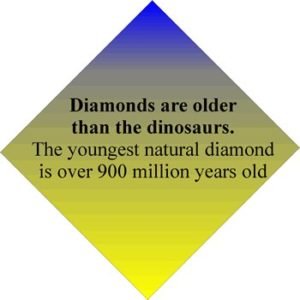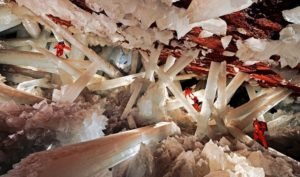CRYSTALS “The Flowers of the Mineral Kingdom”

Crystallography is the study of crystals. The father is Abbe Hauy. The most obvious characteristic of crystals is transparency and geometric regularity. There are 14 BRAVAIS LATTICES grouped into 7 SYSTEMS. X-rays passing through a crystal scatter in a regular pattern. All minerals crystallize into their own individual lattice structures. All minerals are made of crystals. Crystals can be grown synthetically. A unit cell is the smallest spatial structure possessing the characteristics of the mineral as a whole.
ALL CRYSTALS have symmetry. There are different planes of symmetry and a center of symmetry. Our body has bilateral symmetry. All crystals possess DIAD, TRIAD, TETRAD, or HEXAD symmetry. Systems are defined in terms of symmetry:
SYMMETRY: 3 TYPES: There is always a balanced pattern in the arrangement of the FACES
1. PLANE if cut along the plane there will be a mirror image
2. ARIAL is symmetry around an axis. There are identical faces in identical positions at regular intervals. May have several axis of symmetry 2 fold, 3 fold, 4 fold, 6 fold
3. SYMMETRY ABOUT A CENTER each face has a parallel face to it on the opposite side
The surest way to I.D. a crystal is x-ray diffraction. Crystals are solids with geometrical form and are built up from a large # of tiny units having the same shape – the solid state is synonymous with the crystalline state. ATOMS make up all matter, are in constant motion, and their energy increases as the temperature increases. As the temperature cools, atoms arrange themselves in an ordered structure. The outside shape of a crystal is determined by many inside tiny units that have the same angles and form regular shapes.
FLOURESCENCE: Minerals can glow in a variety of colors when exposed to Ultraviolet light. Impurities in the minerals are “activators”. The color depends on the activator and the kind of U.V. light (long or short wave)
The 6 LATTICE SYSTEMS:
1. CUBIC 12% salt has the highest degree of symmetry.
2. HEXAGONAL 8% of crystals including snowflakes and most gems.
3. TRICLINIC or TRIGONAL: 9% such as wollostonite, rhodonite, kyanite, microcline, axinite, plagioclase, corundum, calcite, hematite, tourmaline, and QUARTZ
4. TETRAGONAL: 10% include rutile, zircon, scheelite, scapolite, wulfenite, and chalcopyrite
5. ORTHORHOMBIC: 22% include sulfur, stilinite, arsenopyrite, marcasite, aragonite, witherite, andalusite ,topaz, olivine, cordierite, chalcocite
6. MONOCLINIC: wolframite, azurite, malachite, gypsum, crocoite, vivianite, erythrite, datolite, epidote, stilbite, and pyroxenes
Crystals usually occur in groups in rock fissures, cavities (geodes) or flat surfaces (druses). Sometimes they penetrate one another. MASSIVE Crystals are minerals with crystals too small to be seen. TWINS / Twinning is 2 or more inter-grown crystals as zircon, rutile, cassiterite, staurolite, Iron cross=pyrite. Their formation depends on the geological conditions: Graphite, ice cubes, sand, the metals in bridges, coins, asprin, snowflakes, icicycles, stones, salt, sugar, bones
Crystals often can be as transparent as glass. A small amt. of impurities can cause fantastic changes in color. Impurities are responsible for color changes in stars. Some crystals are electrical conductors.
LUMINESCENCE = a crystal emits light when scratched, tapped, or broken. ex. sugar.
PHOSPHORESCENCE = when crystals glow after a light source is shut off.
FLORESCENCE = when they glow under a UV light
ELECTROLUMINESCENCE = crystals glow when electric current is passed through.
THERMOLUMINESCENCE -= if they emit light when warmed. ex. barite
There are many electronic uses for crystals in lasers, t.v. , telephone, computers
Some crystals generate a small electric current when struck. Squeezing can create a pulse of electricity because of the arrangement of the unit cells as in quartz. Some crystals generate electricity when heated. Tourmaline has no elec. charge but when heated, one end turns + and the other – . As it cools it reverses. Sometimes liquid is trapped in a crystal. In N.Y. someone found calcite crystal with a pint of water trapped inside for 8 million yrs. Sometimes they trap gases too.
Democritus identified the smallest piece of matter as atoms. Each element is made up of different kinds of atoms. You combine 2 or more atoms to make molecules. An atom is mostly empty space and resembles a solar system. It consists of a nucleus of protons and neutrons with electrons spinning around it. The electrons can make quantum jumps in orbit around the nucleus. A magnet or a + electric charge will cause a light beam to swerve.
Atoms build matter in the three forms of a solid, liquid or gas. Crystals grow from gases or liquids! Atoms go from disorder to order. Atoms are always in motion. Molecules have qualities like a magnet with a + or – charge and attract or repel. The electrical charge can be weak or strong. Two factors determine the state of matter = molecular motion and electrical attraction.
A GAS has no shape, size, or volume and molecules have a weak attraction for each other and there is almost total disorder. There is a resistance of a gas to an object moving through it and the resistance can add up as the breeze you feel when you ride a bike or swing. Atoms of most gases team up to make molecules. The NOBLE GASES do not pair up = helium, neon, argon
LIQUIDS do not have shape but they have size and volume. They don’t spread out like gases. The molecules stick together but slip and roll over each other. It takes more force to push molecules apart than air!
SOLIDS have volume; take up space, and have a definite shape. The molecules bound together vibrate! CRYSTALS are molecules arranged in the highest degree of order – the solid. It has billions of tiny crystals.
THE 4th STATE of matter is PLASMA = a hot gas with no electrons.
5th STATE = SUPERSOLIDS packed tight under extreme pressure.
CRYSTALS are like “frozen ice”. Most crystals are too small to see with the naked eye. Crystals are groups of atoms, molecules, or compounds that have firmly clumped together like bricks layered from a disorderly pile. The electrical forces within give them their shape!
Crystals need nuclei to form:
1. Around dust particles
2. In supersaturated solutions (warm liquid dissolves more solid matter)
Heat puts atoms in motion. Cold slows atoms down. The bonds that hold molecules together are of different strengths. Each kind of molecule has a unique shape of it’s own. Freezing temps and boiling temps vary depending on the strength of the bonds. The freezing point and melting point are almost identical.
Sublimation is when gas turns to solid or solid to gas with no liquid step.
Quartz is the most abundant crystal has unit cells of 3 silicon dioxide mol. clasped together in repeated patterns. It takes time and freedom to form perfect crystals – the less time and freedom the more defects. Glass is not crystalline but a supercooled liquid that becomes hard so quickly there is no time for crystals to organize. It is amorphous and has no shape to it’s structure.
The final shape of natural crystallization is it’s HABIT = the preferred mode of growth = the arrangement and proportion of faces on a single Crystal.
HABITS:
1. Acicular needlelike – natrolite
2. Bladed broad flatlike blade – gypsum
3. Dendritic treelike or branching – copper
4. Equant = same diameter in every direction – garnet
5. Prismatic elongated in one direction – tourmaline
6. Striated shallow parallel grooves on 1 or more faces – pyrite
7. Tabular thick or thin flat plates – wulfenite
Most minerals lock together in more than one pattern depending on temp. pressure, and saturation. They have more than one habit = ALLOTROPIC “variety”. Habits change. They change from 1 habit to another as the temperature drops. Water is a mineral with 4 habits. ASBESTOS has 1 habit = stringy crystals
Carbon has 2 habits: forms graphite in hexagonal system or diamond in cubic system
1. Graphite smooth slippery flat 6 sided molecules easily slide over each other – used as lubricant and to write
2. Pyramid crystals high temp. and great pressure = diamond the hardest
RADIOACTIVITY occurs in some minerals like uranium, thorium. They give off energy as radiation. Some are a rich orange, green or yellow in color. Some minerals respond to a magnet, usually the iron bearing minerals. Lodestone is a natural magnet, and varieties of magnetite, franklinite, hematite, chromite, pyrrhotite, ilmenite. Magnetism grows stronger when heated and depends on the amt. of iron content.
OTHER PROPERTIES:
TASTE: a mineral must be soluble in water to have taste as salt, epsomite, borax
ODOR: arsenopyrite = garlic, kaolinite = earthy, Pyrite = sulfurous
FEEL: soft, smooth like chalk (a rock composition of microscopic fossil shells)
Acid test for carbonate minerals: crush some and add a few drops of acid and they will bubble = aragonite, calcite, dolomite
LIQUID CRYSTALS are crystals that have characteristics of liquid and solid states. Can be poured yet molecules arrange themselves in rows side by side. Some change color with a small temp. change. The membranes surrounding brain cells are made of liquid crystals. Our sense of smell may be due to liquid crystals. Most liquid crystals change the way they group together when exposed to different chemical vapors!
CRYSTAL WISKERS are single perfect crystals and are very strong. They were discovered as interference in miniature electrical equip.
METALS a few dislocations or mismatches make a metal soft with wider planes of slippage. Many dislocations make it hard.
Gems are minerals that have ornamental value of beauty, durability, rarity (about 20 minerals). The most valuable gems are at least as hard as quartz. There are about 2500 minerals known and they are of many different COLORS or can be multicolored or banded or metallic. Gems have outstanding transparency, luster, color. They are prized for their beauty. With little or no flaws they are cut, shaped or polished.
1. FACETED for brilliance = diamond
2. POLISHED for stars, colors and patterns = tigers eye or sapphire
3. CARVED as jade, turquoise, or agate
ROCK is an aggregate of minerals. We learn about the earth’s history from understanding the differences in rocks and how they are formed and from fossils. Minerals like rocks form under a variety of conditions of heating, cooling and pressure.

Natural Crystal Cave Nacia, Mexico

